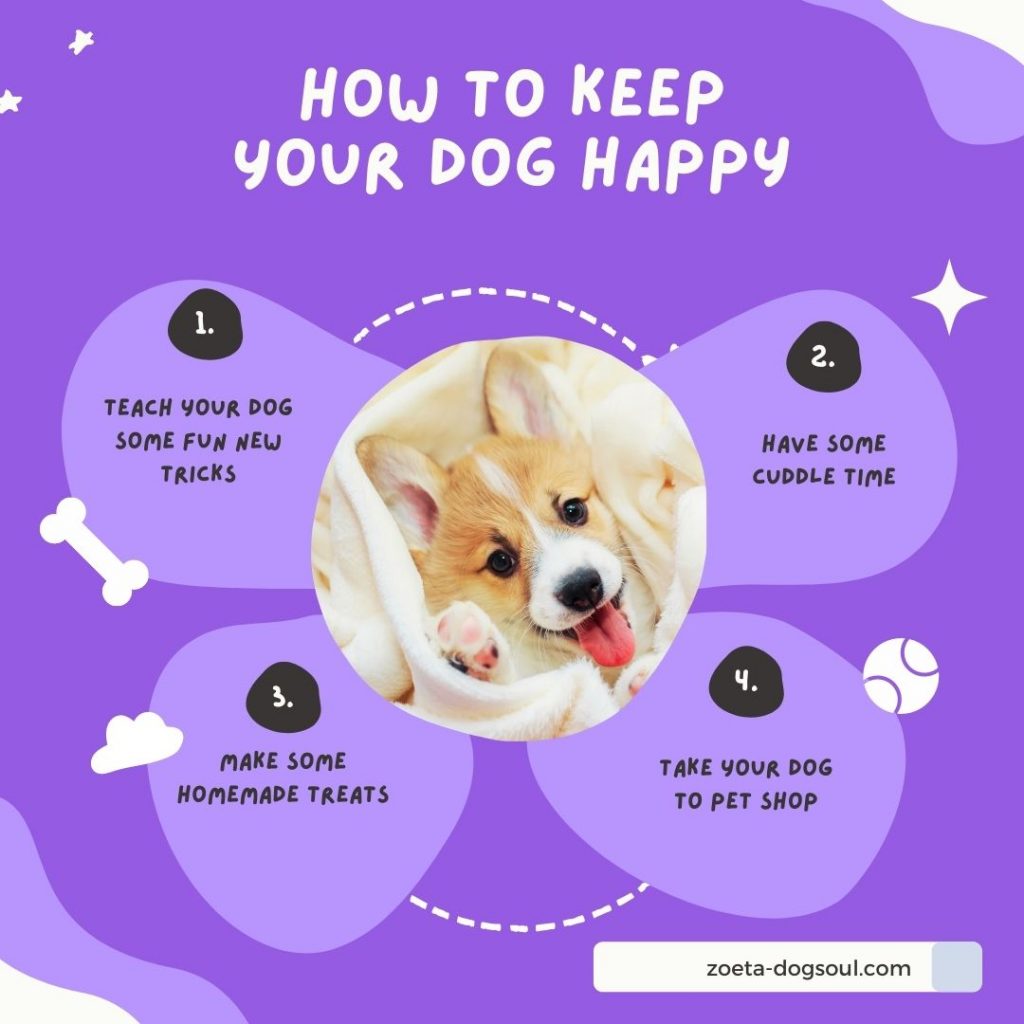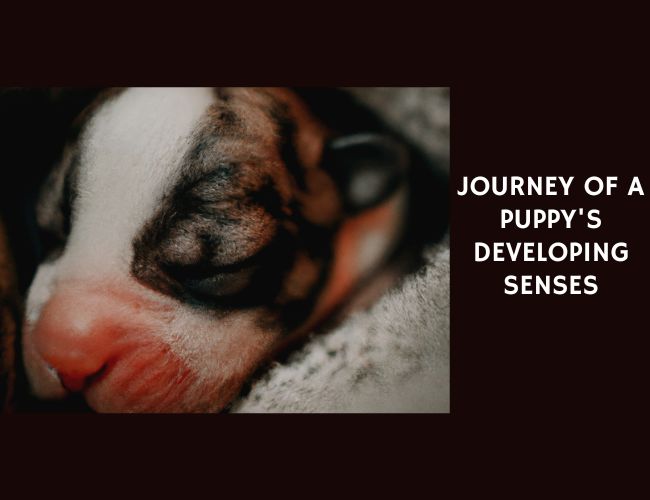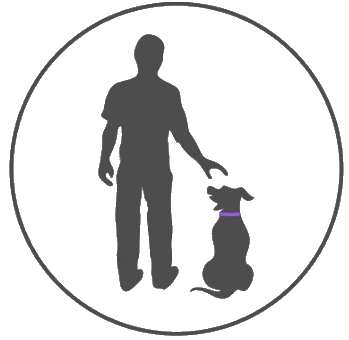The world is a veritable playground of sensory experiences for puppies, filled with sights, sounds, smells, tastes, and tactile sensations. Just as human infants must learn to navigate their environment through a rapidly developing sensory system, the same is true for our furry friends. The sensory journey of a puppy unfolds in an intriguing way – starting even before birth and continuing to evolve throughout their early life. It’s a fascinating process that we’ll delve into, shedding light on how these adorable creatures perceive the world around them.
Understanding sensory development in puppies
Understanding this sensory development in puppies isn’t just a matter of curiosity; it’s also crucial for their wellbeing. A puppy’s ability to interact with its surroundings depends heavily on its senses. The more aware we are of how these senses develop, the better equipped we’ll be to provide nurturing care. Moreover, a clear understanding of a puppy’s sensory development can help us to create environments that stimulate their growth in healthy ways.
Throughout this blog post, we’ll explore the different stages of a puppy’s sensory development, starting from when they are newborns. We will discuss the importance of touch stimuli, balance sense, and temperature sensors in orienting them to their surroundings. We’ll also delve into the impact of prenatal experiences and environmental stimuli on their sensory perception.
Furthermore, we’ll examine the development of specific senses post-birth, such as visual acuity and the establishment of nerve tracts leading to the brain. We’ll also discuss the role these senses play in a puppy’s survival, aiding them in finding food, warmth, and navigating their surroundings. By the end of this journey, we hope you gain a deep appreciation of the intricate sensory world of puppies and the profound influence we have in shaping their sensory experiences.
Newborn Puppies and Their Senses
When a puppy is born into the world, its reality is vastly different from ours. At this stage, their senses are underdeveloped, leaving them reliant on touch stimuli to navigate their new environment. As you may know, puppies are born with their eyes and ears closed. Thus, their primary sensory input comes through the skin, particularly the muzzle area. This makes the sense of touch a vital lifeline for newborn pups.
Have you ever wondered why mother dogs carefully lick their newborns? This act serves a dual purpose. Besides cleaning the puppies, mothers also stimulate their babies’ tactile sensations. The soft strokes of the mother’s tongue provide essential sensory inputs, triggering the puppies’ first conscious experiences and helping them recognize their mother’s presence.
As we move beyond the sense of touch, let’s explore how balance and temperature perception play a role in early life. Despite their limited mobility, newborn puppies have an innate ability to orient themselves using balance and temperature sensors. This might seem surprising, but these tiny beings can detect gradients of warmth and instinctively move towards it. This behavioral pattern, known as ‘positive thermotaxis’, guides the newborns towards their mother and littermates, ensuring they stay warm and safe.
Balance, or the vestibular sense, although rudimentary at birth, also plays a crucial part in a puppy’s orientation. Ever noticed how puppies huddle together or press against their mother? This is not just a quest for warmth but also an unconscious effort to maintain equilibrium. The pressure sensation felt when they lean against each other helps the puppies stabilize and enhance their developing sense of balance.
Despite being born into a world of darkness and silence, these fascinating creatures use touch, balance, and temperature perception to familiarize themselves with their surroundings. Their ability to do so underscores the remarkable adaptability of life and gives us a glimpse into the extraordinary journey of a puppy’s developing senses.
The Role of Prenatal Experiences in Sensory Perception Development
Before we dive into the fascinating world of puppies and their senses, it’s important to note that a dog’s sensory journey begins way before its birth. Yes, you read that right – prenatal experiences significantly influence the development of a dog’s sensory perception. Much like human babies, unborn puppies have a rich sensory life within the womb, and these early experiences lay a significant foundation for their perceptions and interactions with the world post-birth.
While nestled comfortably in their mother’s womb, puppies start developing their senses. But what factors contribute to this early sensory maturation? First, it’s necessary to understand that the pregnant dog’s welfare plays a critical role in this process. A healthy, stress-free, well-nourished mother provides the optimal environment for the unborn puppies’ senses to flourish.
Nutrition and Sensory Development
A balanced diet for the mother dog is essential to the puppies’ sensory maturation. Essential nutrients, proteins, and vitamins are key contributors to the development of the puppies’ sensory organs. For instance, deficiencies in certain vitamins during pregnancy can lead to sensory impairments in puppies, emphasizing the importance of proper nutrition.
Environmental Stimulation
Environmental stimulation also contributes significantly to prenatal sensory development. Vibrations and sounds experienced in the womb can stimulate the puppies’ senses, preparing them for similar stimuli in the real world. In fact, research suggests that exposure to a variety of gentle sounds and vibrations during pregnancy can result in puppies that are more calm and adaptable to different environments post-birth.
Maternal Stress and Sensory Development
It’s worth noting that maternal stress can impact the unborn puppies’ sensory development. High levels of stress hormones in the mother can cross the placental barrier, potentially affecting the puppies’ developing nervous system. Consequently, maintaining a serene and supportive environment for the mother dog is of paramount importance.
In essence, prenatal experiences provide the first building blocks in a puppy’s sensory journey. These experiences influence not just their sensory perceptions, but also their ability to interact with the world once they are born, making it a crucial aspect of canine development. The unborn puppies’ senses are nurtured by good nutrition, environmental stimuli, and low stress levels in the mother. Hence, ensuring the well-being of the pregnant dog can set the stage for healthy and well-adjusted puppies.
The Influence of Environmental Stimuli on Puppies
It’s an incredible world out there, filled with a myriad of stimuli that puppies must learn to navigate. Among the most vital environmental signals they encounter are pressure and vibration. These stimuli play a significant role in shaping their interactions and understanding of the world around them.
Pressure and Vibration: Essential Environmental Cues
As puppies grow, they start to become more aware of their surroundings, and this includes the subtle cues of pressure and vibration. When a puppy moves or explores its environment, it encounters various forms of physical contact. This can range from the soft pressure of their mother’s fur to the hard surface of their playing area. As they experience these different textures and surfaces, puppies gradually learn to distinguish between them. This awareness assists them in developing spatial orientation and also helps them understand their boundaries within their environment.
Vibration, on the other hand, is another fascinating aspect of their sensory exploration. Puppies are sensitive to vibrations and can detect them through their footpads and body. This sense often alerts them to the presence of other animals or humans, and can even help them locate their siblings or mother when they’re nearby. It’s a crucial survival tool for them, particularly during their early weeks when their visual and auditory senses are not fully developed.
Temperature Changes and Unborn Puppies
Interestingly, not all sensory development starts after birth. Even before a puppy is born, it begins to respond to environmental changes – particularly temperature fluctuations. When the mother’s body experiences temperature changes, these are registered by the unborn puppies. This early exposure to temperature variance helps prepare them for the outside world where they’ll frequently experience shifts in temperature due to weather changes and indoor heating or cooling systems.
This sensory perception is crucial because it assists newborn puppies in seeking warmth immediately after birth, drawn instinctively towards their mother’s body heat. This natural inclination towards warmth is a key survival mechanism for newborn puppies, helping to regulate their body temperature and maintain their overall health.
So, whether it’s pressure, vibration, or temperature changes, puppies are constantly learning and adapting to their environment. These sensory experiences, both pre and post-birth, equip them with the necessary skills to interact with the world, ensuring their survival and well-being.
The Development of Specific Senses Post-Birth
The journey of a puppy’s sensory development doesn’t stop at birth. In fact, some crucial aspects only kickstart post-birth, particularly concerning specific sense organs like the eyes. Just as humans continue to develop and mature in their early years, puppies also undergo a fascinating process of maturation and development in their sensory perception.
Eyesight Development in Puppies
Newborn puppies are born with their eyes shut. It isn’t until approximately two weeks after birth that they start to open their eyes. But even then, their vision isn’t fully developed. Initially, puppies are only able to perceive light and movement. Over the following weeks, their eyesight gradually improves as their retinas mature and their eye muscles strengthen. By around eight weeks old, most puppies have near-adult vision capabilities. However, it’s important to note that every puppy is unique, and their development rate can vary based on their breed and individual genetic factors.
Development of Nerve Tracts
Another significant aspect of a puppy’s post-birth sensory development is the establishment of nerve tract connections to the brain. This process is fundamental for the interpretation of sensory stimuli, including those related to sight. During the first few weeks of a puppy’s life, nerve tracts gradually establish interconnections leading to the brain. These connections enable the processing and interpretation of optical stimuli, contributing significantly to the puppy’s growing understanding of its surroundings.
The growth and strengthening of these nerve pathways are influenced by both genetic factors and environmental stimuli. Just like in humans, learning and experience play a key role in shaping the neural connections in a puppy’s brain. This process, known as synaptic pruning, involves the strengthening of frequently used connections and the elimination of less-used ones. Thus, the experiences a puppy has in its early life can significantly impact its sensory perception and cognitive abilities later in life.
In essence, the post-birth period is a critical phase in a puppy’s sensory development journey. The maturation of their eyes and the establishment of nerve connections are vital processes that enable them to make sense of their world. Providing puppies with a nurturing, stimulating environment during this time can help foster healthy sensory development, ensuring they grow into well-adjusted, cognitively capable adult dogs.
Nerve cells, also known as neurons, are the fundamental units of the nervous system. They are specialized for intercellular communication and have a unique structure that facilitates this function. Each neuron is composed of three main parts: the cell body or soma, one or more dendrites, and a single axon.
The cell body is similar to other types of cells, containing essential organelles such as the nucleus, endoplasmic reticulum, ribosomes, Golgi apparatus, and mitochondria. The dendrites are branch-like projections that extend from the cell body, receiving signals from other cells and transmitting them to the soma. The axon, on the other hand, is a long fiber that carries information originating from the soma to other nerve cells. This structure allows each individual nerve cell to function as both a signal-receiving and a signal-delivering element in the vast structure of the nervous system.
Sensory cells can be considered as transformed nerve cells whose processes have become stimulus-receiving structures, functioning as receptors for sensory stimuli. Based on their structure and interconnection, three types of sensory cells are distinguished: primary sensory cells, sensory nerve cells, and secondary sensory cells. Primary sensory cells receive stimuli through sensitive cell processes, with the triggered nerve impulses transmitted via the axon of the same cell to the central nervous system. Examples include olfactory sensory cells and single tactile receptors. Sensory nerve cells have their cell bodies located at or in the central nervous system.
Their stimulus-receiving end fibers, often strongly branched or equipped with auxiliary structures, serve as free nerve endings. Examples include cold, warm, and pain receptors, as well as individual tactile receptors of the skin. Secondary sensory cells, always located in a sensory epithelium, have no axon of their own and only undertake the task of stimulus reception. They transmit their excitation to the surrounding branched end fibers of a downstream nerve cell via synaptic contacts.
Examples include hair cells of the organ of hearing and equilibrium, taste cells, and light receptors. These sensory cells or receptors are stimulus-specific, meaning they are exclusively excited by their own kind of stimulus. This ensures that a single information channel only transmits messages about a specific type of stimulus to the central nervous system, allowing for the decoding of different stimulus modalities at a higher level.

The Role of Sensory Perception in Puppies’ Survival
As puppies grow and develop, their sensory perception becomes a vital tool for survival. It’s through these senses that pups learn to locate food, seek warmth, and navigate their environment. These instinctual behaviors are essential for their well-being and growth.
Sensory Perception in Food Seeking and Warmth Detection
The first step in a puppy’s survival journey involves the search for sustenance and comfort. Their sense of smell is particularly instrumental in this regard. Puppies have an innate ability to use scent to find their mother’s milk, even from the moment they are born. This olfactory prowess is nurtured by the strong, distinct scent of their mother and littermates, which also creates a comforting, familiar environment.
In addition, puppies have a keen sense of temperature. Much like human babies, puppies cannot regulate their body temperatures effectively during the first few weeks of life. They rely on physical contact with their mother and siblings for warmth. If they stray too far, their bodies react to the drop in temperature, prompting them to seek out their heat source – usually their mother or littermates.
Navigating Through Sensory Perception
As puppies mature, their ability to interact with and understand their surroundings grows exponentially. Post-birth, their eyesight and hearing continue to develop, paving the way for more complex navigation. Once their eyes open, typically between 10-14 days, their world expands beyond touch and smell. They start discerning shapes, light, and movement, helping them become aware of larger spaces and obstacles.
Their hearing also plays a crucial role. Although puppies are born deaf, their ears begin to open around the same time as their eyes. With this newfound auditory sense, they can respond to sounds, recognize their mother’s call, and even start understanding basic commands. Moreover, their sense of balance, largely governed by the inner ear, helps them maintain stability while exploring and playing.
From the moment they are born, puppies navigate their world primarily through their sense of smell. Their eyes are closed and their hearing undeveloped, leaving them to rely on their olfactory abilities to find their mother and siblings. This is made possible by a special organ located on the roof of their mouth, known as Jacobson’s organ. The unique aroma that puppies emit, often compared to everything from vanilla malt to freshly cut hay, is still a mystery to scientists. However, it is believed that these sweat secretions produce an individual odor signal that is recognizable by other dogs.
Dogs also have sweat glands on their noses, known as eccrine glands, which contribute to their scent. The canine olfactory system is incredibly powerful, with a dog’s sense of smell estimated to be 100,000 times more potent than a human’s. Dogs have about 2 billion olfactory receptors, significantly more than our 40 million. They can detect not only specific scents of drugs or explosives but also changes in emotions and health conditions in humans. Newborn puppies, despite their underdeveloped senses, are believed to have a limited ability to perceive odors through their nose. The electrical activity of the nasal olfactory nerve fibers is hardly measurable at this stage, and the corresponding olfactory center in the brain is relatively underdeveloped. However, it is assumed that even newborns can register and identify individual odorants, particularly those emanating from their mother’s milk.
Experiments with a few days old puppies have shown that they can also perceive neutral scents, such as those of anise seeds. However, their ability to perceive and differentiate odors is not as impressive as it will be later in life. The sensitivity of the vomeronasal olfactory sensory cells is also far from perfect at this stage. These cells become more important as the puppies reach sexual maturity, allowing them to detect sex pheromones. In conclusion, while newborn puppies may not have the full olfactory capabilities of adult dogs, they are still able to use their sense of smell to navigate their immediate environment and identify key scents. As they grow and develop, their olfactory abilities will continue to improve, allowing them to perceive the world in a way that humans can only imagine.
Conclusion
In wrapping up this fascinating exploration of a puppy’s sensory journey, it’s important to recap the pivotal stages and factors that shape their sensory development. We’ve seen how the sensory world of puppies is significantly different from our own, beginning with limited senses at birth and gradually maturing over time.
The intriguing journey starts with newborn puppies primarily relying on the sense of touch, balance, and temperature sensors for orientation and survival. Their world, at this stage, is largely defined by tactile stimuli and the warmth of their mother. Prenatal experiences also play a significant role in shaping sensory perception, with environmental influences like pressure, vibration, and temperature changes leaving lasting impacts.
Post-birth development opens up a new array of sensory experiences for puppies. The eyes continue to mature, while nerve tracts establish extensive interconnections leading to the brain, enabling puppies to process optical stimuli. This evolution of senses is crucial, not just for their survival but also for their interaction with the world around them. Sensory perception aids puppies in finding food, seeking warmth, and navigating their surroundings, laying down the foundation for their future behaviors and responses.
Understanding this complex process of sensory development underscores the importance of providing an optimal environment for puppies to grow. A calm, nurturing environment ensures that the sensory stimuli they encounter are positive and beneficial, fostering healthy mental and physical growth. It’s not just about keeping them safe and well-fed; it’s about ensuring that their sensory journey contributes to their overall well-being and prepares them for a happy, healthy adult life.
As we conclude, remember that each puppy’s sensory journey is unique, influenced by a myriad of factors ranging from prenatal experiences to post-birth stimuli. By appreciating and understanding this intricate journey, we can better care for our furry friends, guiding them towards a life filled with joy and meaningful experiences.



